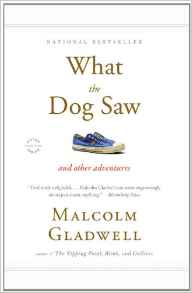Gladwellian Reality

A collection of pieces Malcolm Gladwell has written for The New Yorker magazine since 1996, titled "What the Dog Saw," is a mixed bag of: quirky profiles; thoughtful and contrarian analyses of commonly embraced theories, such as the belief that America’s intelligence services could easily have “connected the dots” and foiled the 9/11 attacks; and predictions people make (about crime, job applicants, pets) that may seem reasonable at first glance, but which aren’t grounded in Gladwellian reality.
The author, who wrote “The Tipping Point” and two other bestselling books, examines, for example, whether pit bulls are inherently dangerous: Not particularly, unless we humans put them up to it.
Then there’s the “Ketchup Conundrum.” Ever wonder why ketchup is just plain ketchup, while mustard, which once was just plain yellow mustard, has morphed into Grey Poupon and myriad other shades, textures, and flavors? Wonder no more: Gladwell is on the case, having delved in great detail into the five fundamental tastes in the human palate, not to mention the arcane nooks and crannies of food marketing. The author also tackles Enron’s collapse, whether novice pilot John F. Kennedy Jr. choked or panicked (there’s a big difference), and why pictures sometimes lie.
In his preface, Gladwell confesses that his first career choice was advertising, and it shows. “The Pitchman,” which won a National Magazine Award, is a delightfully rich account of the immigrant American clan who concocted and sold such household icons as the Veg-O-Matic and the Ronco Showtime Rotisserie.
In another market-driven piece, the author follows the careers of women who had a powerful impact on both what we bought and how we thought about ourselves. In the 1950s, copywriter Shirley Polykoff penned this memorable line for Clairol’s Nice ’n Easy hair-coloring brand: “Does she or doesn’t she? Only her hairdresser knows for sure.” When the ad debuted, seven percent of American women dyed their hair. By the 1970s, when Ilon Specht wrote the more assertive “Because I’m worth it” tag line for Preference by L’Oréal, 40 percent of females were coloring.
At times, Gladwell works too hard at being the devil’s advocate. In “Open Secrets” he doesn’t exonerate Enron exactly, but he points out that the company’s deteriorating condition could have been deduced from a careful reading of its quarterly filings and other public documents – and that in 1998 a group of six business students at Cornell University did just that. They posted their report on the school’s website. So was Enron really hiding anything? Gladwell seems to be implying that too much information is not always useful. Yet he neglects to emphasize that top company officials were asserting right up to the implosion that all was hunky-dory, small print notwithstanding.
Likewise, Gladwell goes to great lengths to let America’s intelligence services off the hook for not “connecting the dots” that led to 9/11. Intelligence failures are a dime a dozen, and he cites several. One wonders from his relentless advocacy why we would bother having an FBI and a CIA at all given the inherent vagaries of sleuthing.
When he avoids pontificating, Gladwell is at his best. His profile of “dog whisperer” Cesar Millan mesmerizes, even though he describes his subject as being “built like a soccer player” – as if one size fits all.